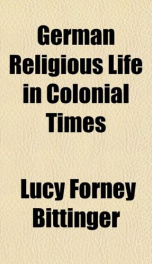german religious life in colonial times

Purchase of this book includes free trial access to www.million-books.com where you can read more than a million books for free. This is an OCR edition with typos. Excerpt from book: CHAPTER III THE CHURCH PEOPLE . The decade of 1730-40 is sometimes distinguished as that of the emigration of the church people ; that is, the members of the two oldest German Protestant organizations, the Lutheran and Reformed bodies.1 But it is a purely arbitrary date, selected more because it embraces a decade than because of any decided change in the character of the emigration at that particular time. There had been a few "church people" mingled with the Separatists and the "sects," ever since the Falkner brothers were ordained to the Lutheran ministry from the ranks of the Wissahickon Hermits, and Peter Miller was sent to Conestoga to save the little Reformed congregation there. But from this fourth decade of the eighteenth century onward the sects outside of the "great church" (as they frequently designated the two churches taken together) and the individual Separatists no longer composed the overwhelming majority of the immigrants. The two churches in their German home had been so like in doctrine, polity and customs of worship that a member of one could scarcely tell what were the distinctive points of his organization in respect to the other. In earlier times, it is true, there had been muchbitterness between them, and the Reformedalways the stronger from its cradle in Zwingli's home, Switzerland, along the whole course of the Rhinehad persecuted the weaker Lutheran Church. But subsequently, with the extinction of the Protestant line in the Pfalz and the accession of the Catholic princes of the Neuburg line, all Protestants were so harried and distressed that mutual suffering drew the warring churches together. One influenced the other. The Lutheranism of the Rhine country was not so churchly as that of Luther's fatherland, Saxony ; the denomination itself ...
Info about the book
Author:
Series:
Unknown
ISBN:
0271023678
Rating:
2.5/5 (2)Your rating:
0/5
Languge:
English
Users who have this book
Users who want this book
What readers are saying
What do you think? Write your own comment on this book!
write a commentif you like german religious life in colonial times try:
Other books by this author
Do you want to read a book that interests you? It’s EASY!
Create an account and send a request for reading to other users on the Webpage of the book!


